check engine CHEVROLET MONTE CARLO 1997 5.G Owners Manual
[x] Cancel search | Manufacturer: CHEVROLET, Model Year: 1997, Model line: MONTE CARLO, Model: CHEVROLET MONTE CARLO 1997 5.GPages: 358, PDF Size: 19.11 MB
Page 14 of 358
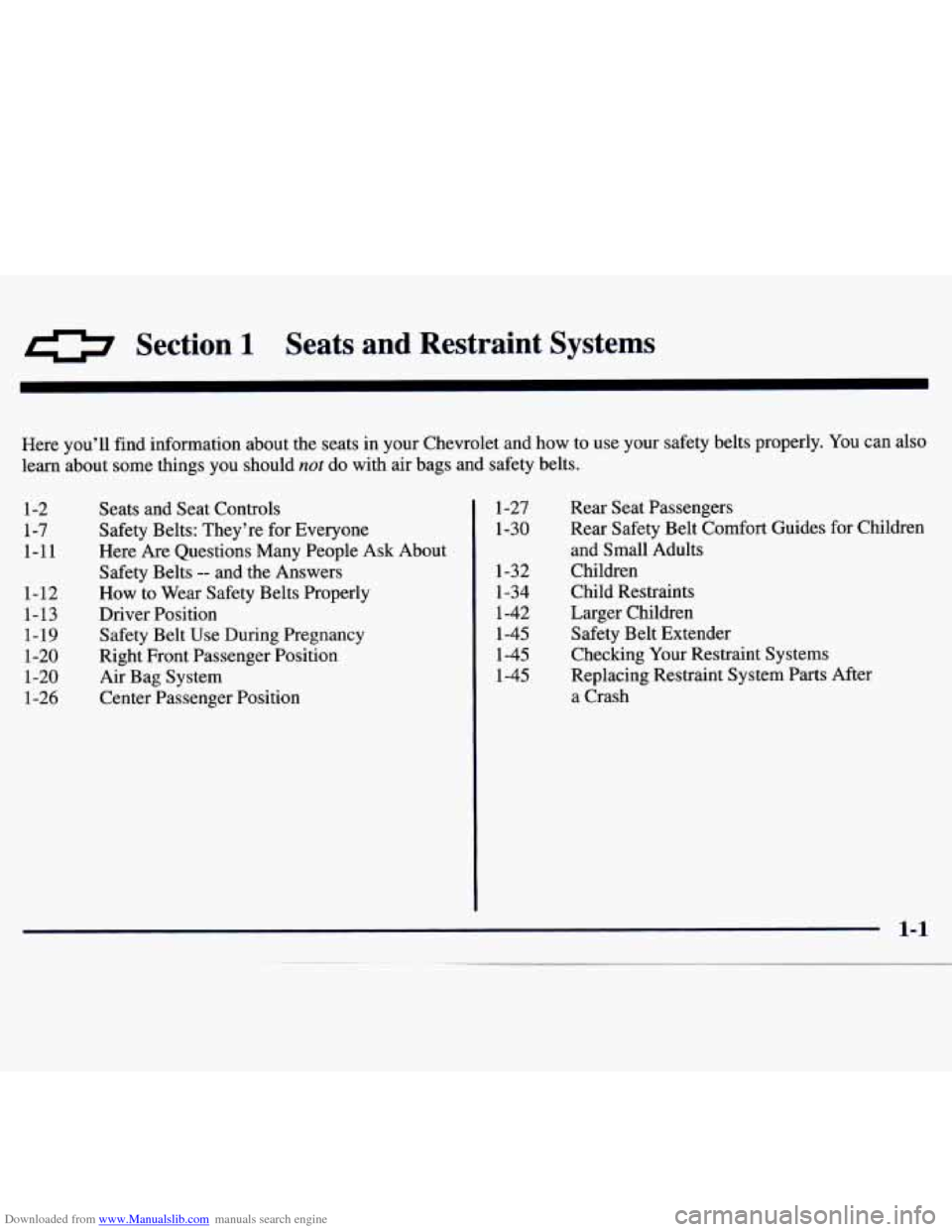
Downloaded from www.Manualslib.com manuals search engine Section 1 Seats and Restraint Systems
Here you’ll find information about the seats in your Chevrolet and how to use your safety belts properly. You can also
learn about some things you should
not do with air bags and safety belts.
1-2
1-7
1-11
1-12
1-13 1-19
1-20
1-20
1-26
Seats and Seat Controls
Safety Belts: They’re for Everyone
Here Are Questions Many People Ask About
Safety Belts
-- and the Answers
How to Wear Safety Belts Properly
Driver Position
Safety Belt Use During Pregnancy
Right Front Passenger Position
Air Bag System Center Passenger Position
1-27
1-30
1-32
1-34
1-42
1-45
1-45
1-45
Rear Seat Passengers
Rear Safety Belt Comfort Guides for Children
and Small Adults
Children
Child Restraints
Larger Children
Safety Belt Extender
Checking
Your Restraint Systems
Replacing Restraint System Parts After
a Crash
Page 20 of 358
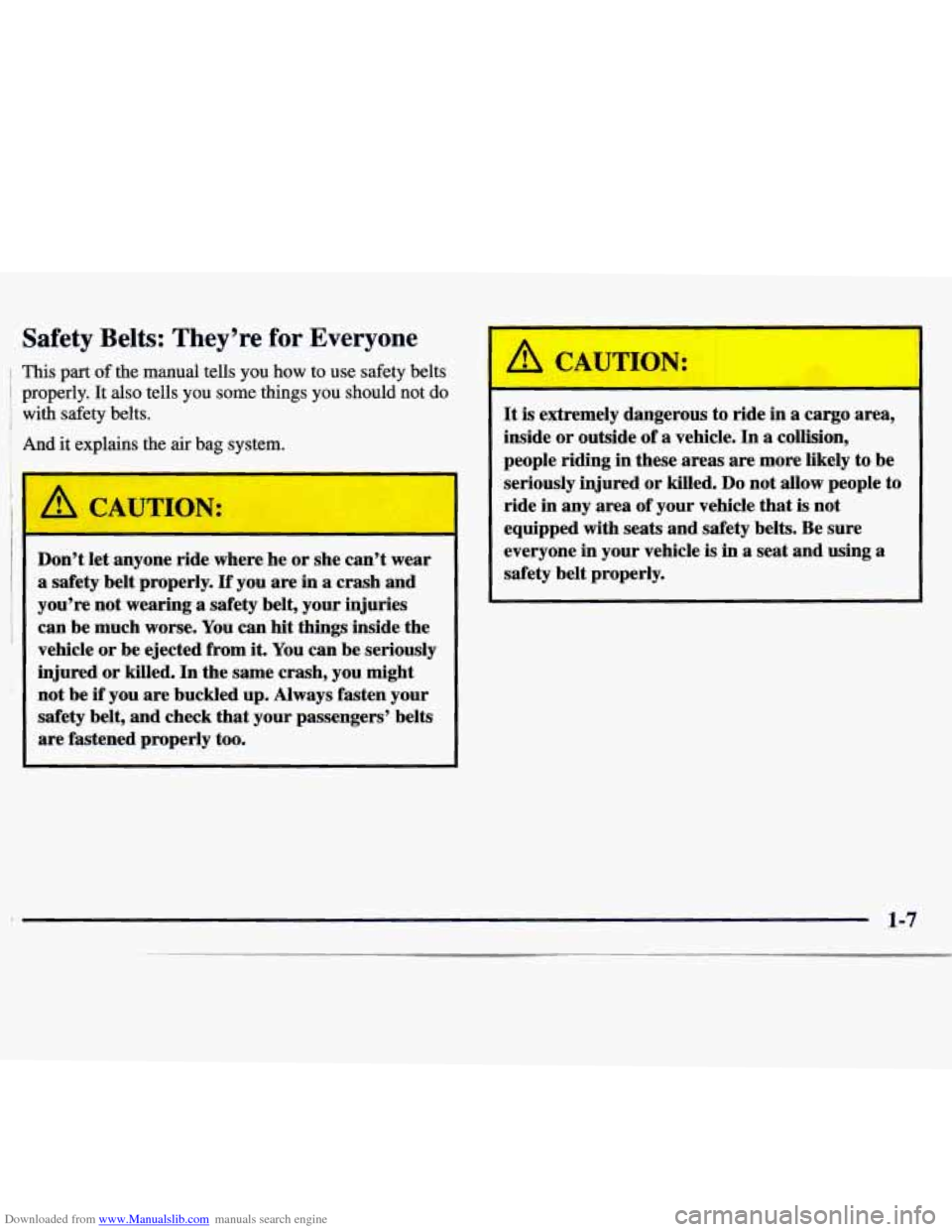
Downloaded from www.Manualslib.com manuals search engine Safety Belts: They’re for Everyone
1 This part of the manual tells you how to use safety belts
j properly. It also tells you some things you should not do
’ with safety belts. I
And it explains the air bag system.
Don’t let anyone ride where he or she can’t wear
a safety belt properly. If you are in a crash and
you’re not wearing a safety belt, your injuries
can be much worse. You can hit things inside the
vehicle or be ejected from
it. You can be seriously
injured or killed. In the same crash, you might
not be
if you are buckled up. Always fasten your
safety belt, and check that your passengers’ belts
are fastened properly too. It
is extremely
dangerous to ride in a cargo area,
inside or outside of
a vehicle. In a collision,
people riding
in these areas are more likely to be
seriously injured or killed. Do not allow people to
ride in any area of your vehicle that is not
equipped with seats and safety belts. Be sure
everyone in your vehicle is in
a seat and using a
safety belt properly.
1-7
Page 34 of 358
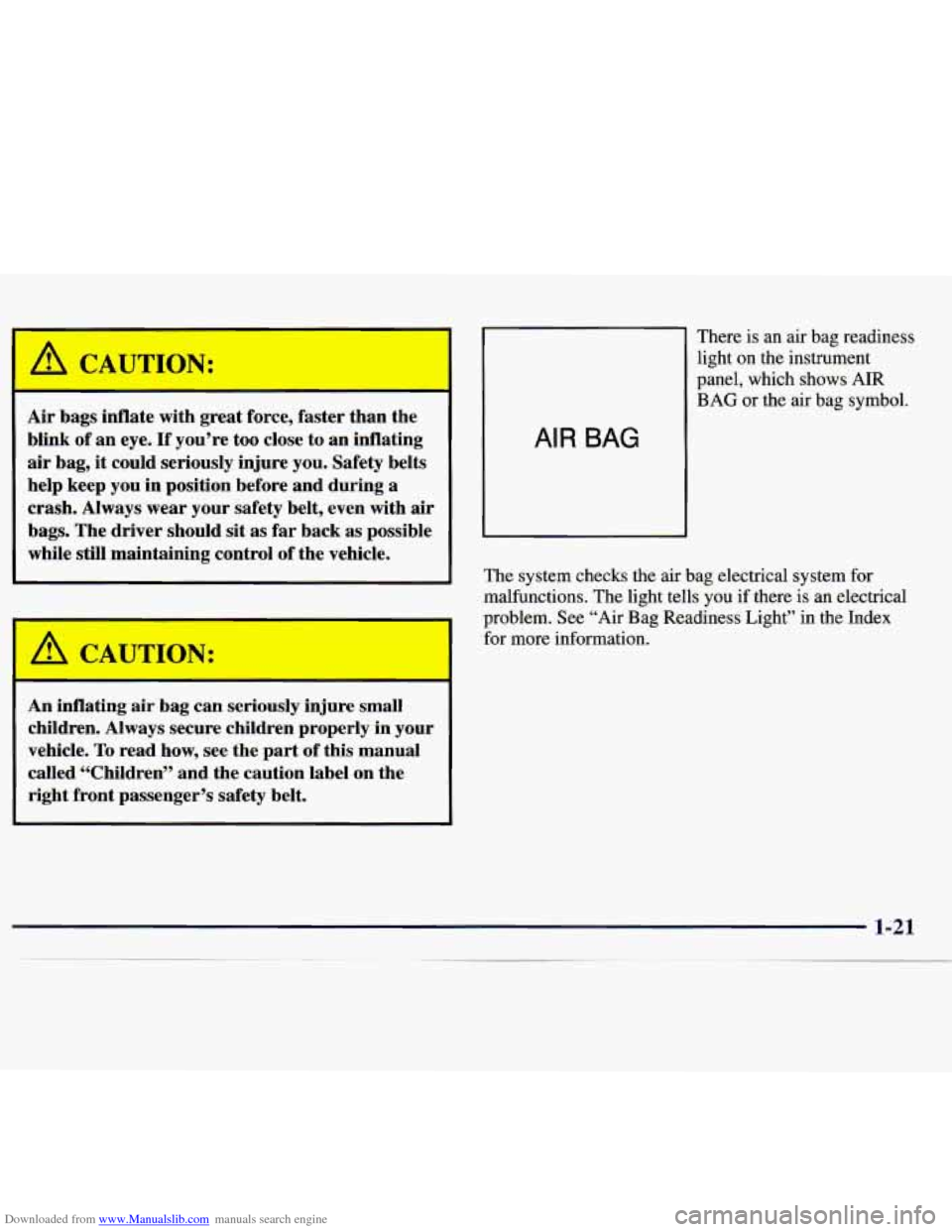
Downloaded from www.Manualslib.com manuals search engine I
A CAI
m
1
Air bags inflate with great force, faster than the
blink of an eye.
If you’re too close to an inflating
air bag, it could seriously injure you. Safety belts
help keep you in position before and during a
crash. Always wear your safety belt, even with
air
bags. The driver should sit as far back as possible
while still maintaining control of the vehicle.
A CAUTION:
-
An inflating air bag can seriously injure small
children. Always secure children properly in your
vehicle.
To read how, see the part of this manual
called “Children” and the caution label on the
right front passenger’s safety belt.
-1
There is an air bag readiness
light on the instrument
AIR BAG
panel, which shows AIR
BAG or the air bag symbol.
The system checks the air bag electrical system for
malfunctions. The light tells you if there is an electrical
problem. See “Air Bag Readiness Light” in the Index
for more information.
Page 58 of 358
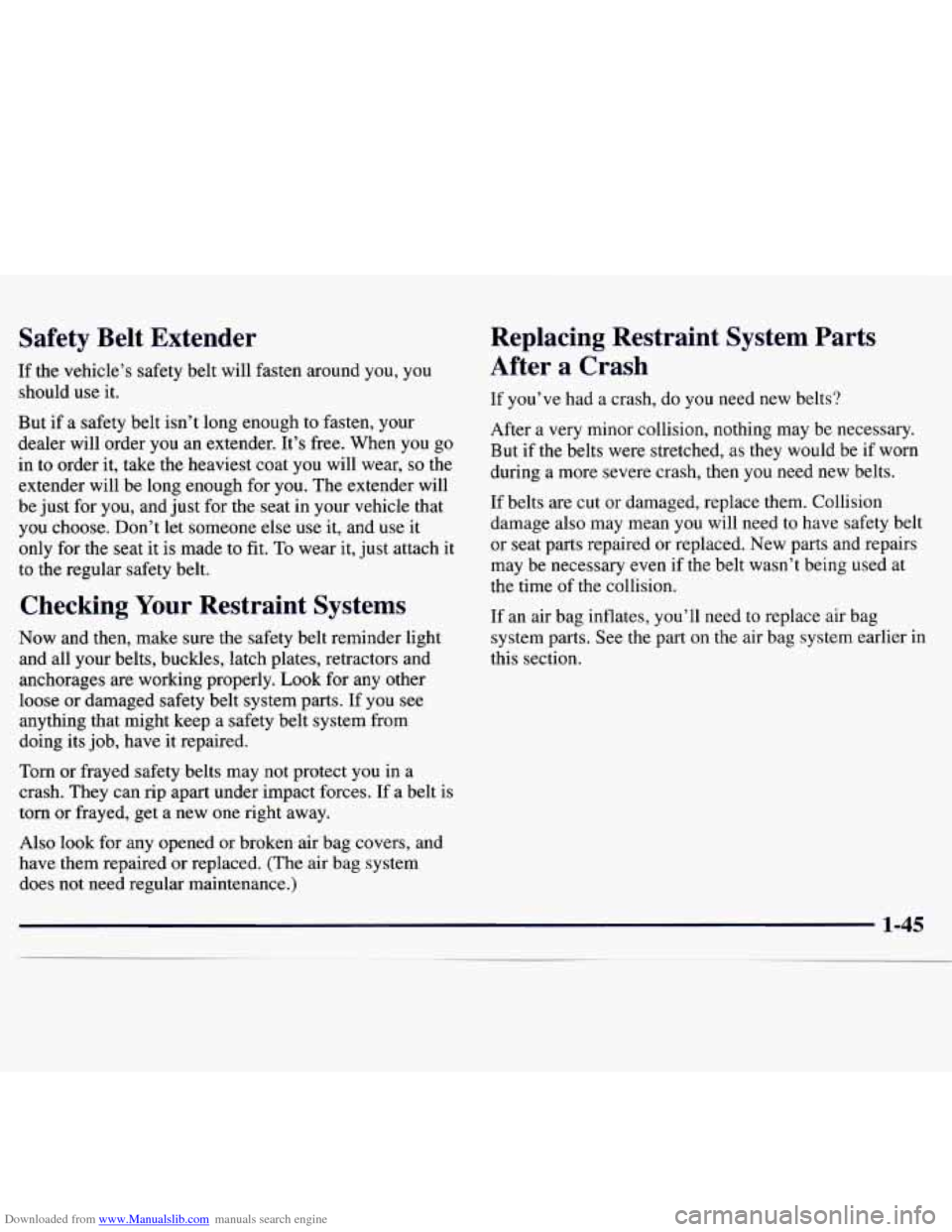
Downloaded from www.Manualslib.com manuals search engine Safety Belt Extender
If the vehicle’s safety belt will fasten around you, you
should
use it.
But if a safety belt isn’t long enough to fasten, your
dealer will order you an extender. It’s free. When you go
in to order it, take the heaviest coat you will wear,
so the
extender will be long enough for you. The extender will
be just for you, and just for the seat in your vehicle that
you choose. Don’t let someone else use it, and use it
only for the seat it is made to fit. To wear it, just attach it
to the regular safety belt.
Checking Your Restraint Systems
Now and then, make sure the safety belt reminder light
and all your belts, buckles, latch plates, retractors and
anchorages are working properly. Look for any other
loose or damaged safety belt system parts. If you see
anything that might keep a safety belt system from
doing its job, have it repaired.
Torn or frayed safety belts may not protect you in a
crash. They can rip apart under impact forces. If a belt is
torn or frayed, get a new one right away.
Also look for any opened or broken air bag covers, and
have them repaired or replaced. (The air bag system
does not need regular maintenance.)
Replacing Restraint System Parts
After a Crash
If you’ve had a crash, do you need new belts?
After a very minor collision, nothing may be necessary.
But if the belts were stretched, as they would be if worn
during a more severe crash, then
you need new belts.
If belts are cut or damaged, replace them. Collision
damage also may mean you will need to have safety belt
or seat parts repaired or replaced. New parts and repairs
may be necessary even if the belt wasn’t being used at
the time of the collision.
If an air bag inflates, you’ll need to replace air bag
system parts. See the part
on the air bag system earlier in
this section.
Page 64 of 358
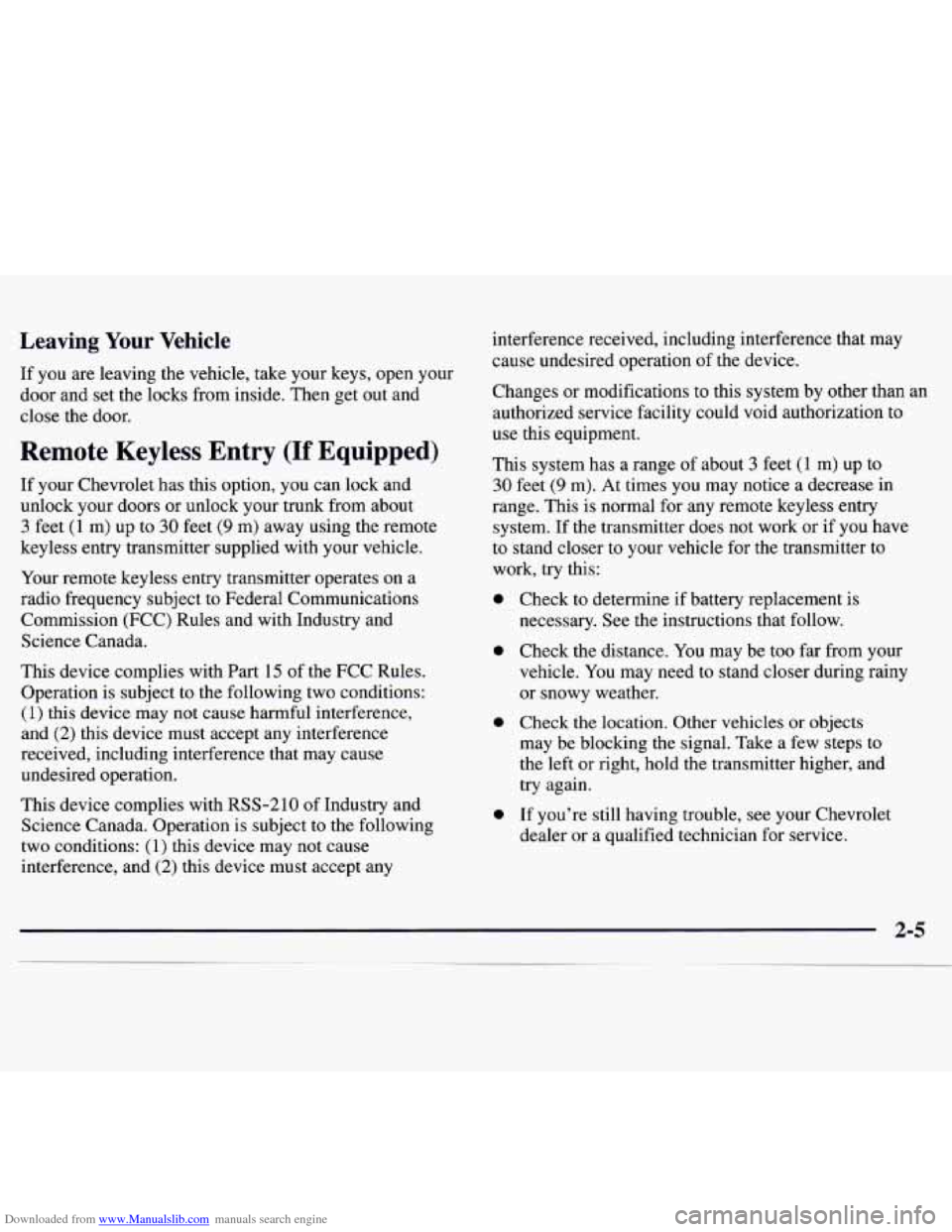
Downloaded from www.Manualslib.com manuals search engine Leaving Your Vehicle
If you are leaving the vehicle, take your keys, open your
door and set the locks from inside. Then get out and
close the door.
Remote Keyless Entry (If Equipped)
If your Chevrolet has this option, you can lock and
unlock your doors or unlock your trunk from about
3 feet (1 m) up to 30 feet (9 m) away using the remote
keyless entry transmitter supplied with your vehicle.
Your remote keyless entry transmitter operates on a
radio frequency subject to Federal Communications
Commission (FCC) Rules and with Industry and
Science Canada.
This device complies with Part 15 of the FCC Rules.
Operation is subject to the following two conditions:
(1) this device may not cause harmful interference,
and (2) this device must accept any interference
received, including interference that may cause
undesired operation.
This device complies with RSS-210 of Industry and
Science Canada. Operation is subject to the following
two conditions:
(1) this device may not cause
interference, and (2) this device must accept any interference
received, including interference that may
cause undesired operation of the device.
Changes or modifications to this system by other than an
authorized service facility could void authorization to
use this equipment.
This system has a range of about
3 feet (1 m) up to
30 feet (9 m). At times you may notice a decrease in
range. This is normal for any remote keyless entry
system. If the transmitter does not work or if you have
to stand closer to your vehicle for the transmitter to
work, try this:
0
0
0
0
Check to determine if battery replacement is
necessary. See the instructions that follow.
Check the distance. You may be too far from your
vehicle. You may need to stand closer during rainy
or snowy weather.
Check the location. Other vehicles or objects
may be blocking the signal. Take a few steps to
the left or right, hold the transmitter higher, and
try again.
If you’re still having trouble, see your Chevrolet
dealer or a qualified technician for service.
Page 70 of 358

Downloaded from www.Manualslib.com manuals search engine When the PASS-Key 11 system senses that someone is
using the wrong key, it shuts down the vehicle’s starter
and fuel systems. For about three minutes, the starter
won’t work and fuel won’t go to the engine.
If someone
tries to start your vehicle again or uses another key
during this time, the vehicle will not start.
This
discourages someone from randomly trying different
keys with different resistor pellets in
an attempt to make
a match.
The ignition key must be clean and dry before, it’s
inserted in the ignition or the engine may not start. If the
engine does not start and the SECURITY light is on, the
key may be dirty or wet. Turn the ignition off.
Clean and
dry the key. Wait about three minutes and try
again. The SECURITY light may remain on during
this
time. If the starter still won’t work, and the key appears
to be clean and
dry, wait about three minutes and try
another ignition key. At
this time, you may also want to
check
the fuses (see “Fuses and Circuit Breakers” in the
Index). If the starter won’t work with the other key, your
vehicle needs service.
If your vehicle does start, the first
ignition key may be faulty. See your Chevrolet dealer or
a locksmith who can service the PASS-Key 11. If
you accidentally use a key that has a damaged or
missing resistor pellet, the starter won’t work and the
SECURITY light will come on. But you don’t have to
wait three minutes before trying another ignition key.
See your Chevrolet dealer or a locksmith who can
service the PASS-Key
I1 to have a new key made.
If you’re ever driving and the SECURITY light comes
on and stays on, you will be able to restart your engine
if
you turn it off. Your PASS-Key 11 system, however, is
not working properly and must be serviced by your
Chevrolet dealer. Your vehicle is not protected by the
PASS-Key
I1 system.
If you lose or damage a PASS-Key
I1 ignition key, see
your Chevrolet dealer or a locksmith who can service
PASS-Key I1 to have a new key made. In an emergency,
call the Chevrolet Roadside Assistance Center at
1-800-CHEV-USA (1-800-243-8872).
2-11
Page 73 of 358
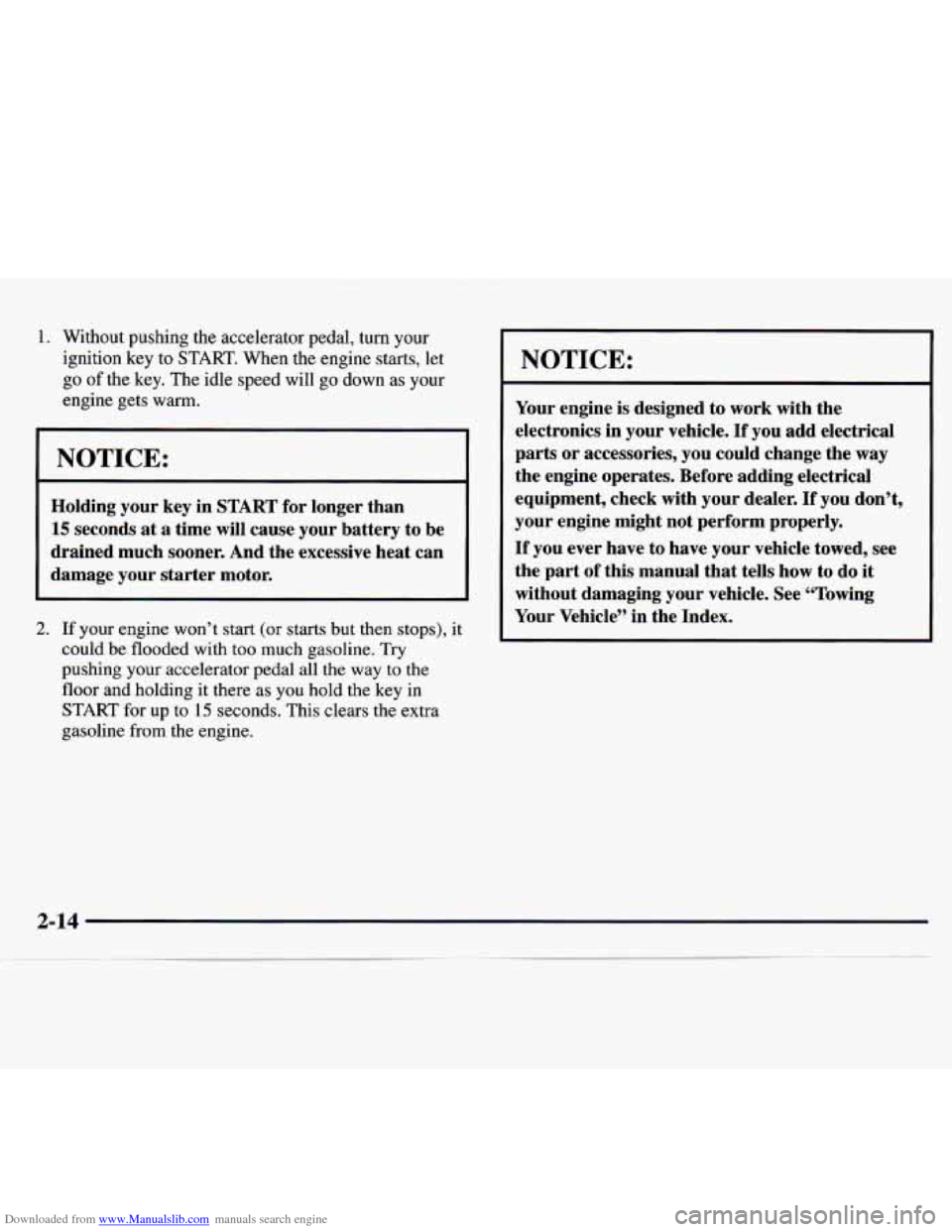
Downloaded from www.Manualslib.com manuals search engine 1. Without pushing the accelerator pedal, turn your
ignition key to
START. When the engine starts, let
go
of the key. The idle speed will go down as your
engine gets warm.
I NOTICE:
Holding your key in START for longer than
15 seconds at a time will cause your battery to be
drained much sooner. And the excessive heat can
damage your starter motor.
2. If your engine won’t start (or starts but then stops), it
could be flooded with too much gasoline. Try
pushing your accelerator pedal all the way to the
floor and holding it there as you hold the key in
START
for up to 15 seconds. This clears the extra
gasoline from the engine.
Your engine is designed to work with the
electronics in your vehicle.
If you add electrical
parts
or accessories, you could change the way
the engine operates. Before adding electrical
equipment, check with your dealer.
If you don’t,
your engine might not perform properly.
If you ever have to have your vehicle towed, see
the part of this manual that tells how
to do it
without damaging your vehicle. See “Towing
Your Vehicle” in the Index.
NOTICE:
2-14
.~ ~
Page 87 of 358

Downloaded from www.Manualslib.com manuals search engine lhrn Signal and Lane Change Indicator
The turn signal has two upward (for right) and two
downward (for left) positions. These positions allow you
to signal a turn or a lane change.
To signal a turn, move the lever all the way up or down.
When the turn is finished, the lever will return
automatically.
An arrow on the instrument
panel will flash in the
direction of the turn or
lane change.
To signal a lane change, just raise or lower the lever
until the arrow starts to flash. Hold
it there until you
complete your lane change. The lever will return by
itself when you release it.
As you signal a turn or a lane change, if the arrow
flashes faster than normal, a signal bulb may be burned
out and other drivers won’t see your turn signal.
If a bulb is burned out, replace it to help avoid an
accident. If the arrows don’t go
on at all when you
signal a turn, check for burned-out bulbs and check the
fuse (see “Fuses and Circuit Breakers” in the Index).
Headlamp HighlLow Beam
To change your headlamps
from low beam to high
beam, or high to low, pull
the multifunction lever all
the way toward you. Then
release it. When the high
beams
are on, a light on the
instrument panel also will
be on.
Page 96 of 358

Downloaded from www.Manualslib.com manuals search engine Inside Daymight Rearview Mirror
To reduce glare from headlamps behind you, push the
lever forward (to the night position).
To return the
mirror to the day position, pull the lever toward you.
Power Outside Mirrors
Convex Outside Mirror
The power mirror control is
on the driver’s door. Turn
the control to the left to
adjust the
left mirror or to
the right
to adjust the right
mirror. Then move the
control in the direction you
want to
move the mirror.
Your passenger’s side mirror is convex. A convex
mirror’s surface is curved
so you can see more from the
driver’s seat.
I
I A CAUTION:
A convex mirror can make things (like other
vehicles) look farther away than they really
are. If
you cut too sharply into the right lane, you could hit
a vehicle on your right. Check your inside mirror or
glance over your shoulder
before changing lanes.
2-37
Page 101 of 358

Downloaded from www.Manualslib.com manuals search engine Usage
4. To remove the mat, pull up on the rear of the mat to
un-snap it from the locator post (see view
B).
5. To re-install the mat, align the grommet in the mat
over the locator post and push down to snap the mat
into place
(see view B).
Auxiliary Power Connection
Your vehicle is equipped
with auxiliary power leads.
These leads can be used
to power aftermarket
electrical equipment
added to your vehicle.
J
They are located on the passenger’s side of the vehicle,
below the glove box and behind what
is referred to as a
“hush panel.” For additional information
on accessing
these leads and electrical hookup, please refer to your
service manual.
NOTICE:
Adding some electrical equipment to your vehicle
can damage it or keep other things from working
as they should. This wouldn’t be covered by your
warranty. Check with your dealer before adding
electrical equipment and never use anything that
exceeds the fuse rating.